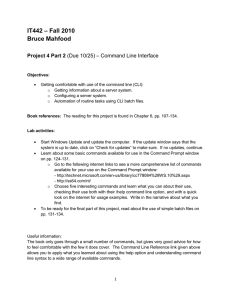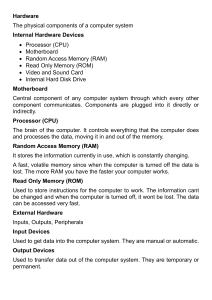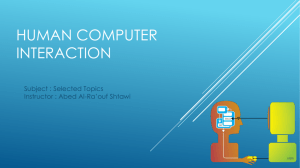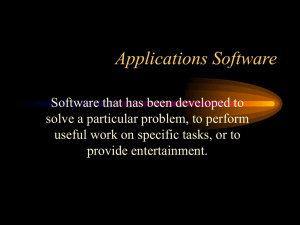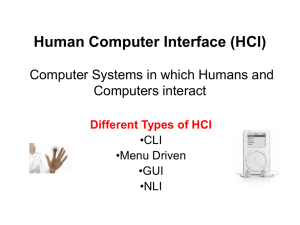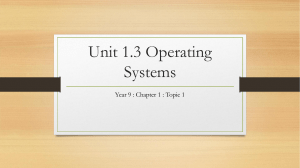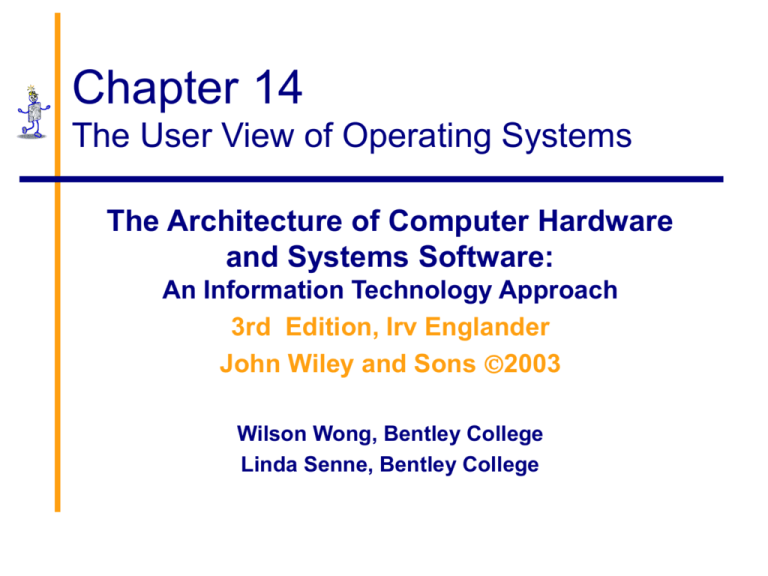
Chapter 14
The User View of Operating Systems
The Architecture of Computer Hardware
and Systems Software:
An Information Technology Approach
3rd Edition, Irv Englander
John Wiley and Sons 2003
Wilson Wong, Bentley College
Linda Senne, Bentley College
User Interface
Help the user use the computer system
productively
Provide consistent user interface
services to application programs to
lower learning curves and increase
productivity
Choice of user interface depends on the
kind of user
Writing programs vs. running applications
Chapter 14
User View of Operating Systems
14-2
User Functions
Program execution
File commands
Mount and unmount devices
Printer spooling
Security
Inter-user communication
System Status
Program Services
DCOM, CORBA, Remote Procedure Call (RPC)
Chapter 14
User View of Operating Systems
14-3
Interface Design
CLI - Command Line Interface
Batch System Commands
Menu-Driven Interfaces
GUI - Graphical User Interface
Chapter 14
User View of Operating Systems
14-4
Command Line Interface
command <operand1> <operand2> …
<switch1> <switch2> …
Operands
keyword (switches) and/or positional
Advantages
More flexible and powerful
Faster for experienced users
Can combine commands
Chapter 14
User View of Operating Systems
14-5
Command Line Interfaces
Chapter 14
User View of Operating Systems
14-6
Command Languages
Provide a mechanism to combine sequences of
commands together. These pseudo-programs are
known as scripts or batch files.
Startup files – OS configuration, user preferences
Features of Command Languages
Can accept input from the user and can output messages to
I/O devices
Provide ability to create and manipulate variables
Include the ability to branch and loop
Ability to specify arguments to the program command and to
transfer those arguments to variables within the program
Provide error detection and recovery
Chapter 14
User View of Operating Systems
14-7
DOS Batch File
Chapter 14
User View of Operating Systems
14-8
UNIX Shell Script
Chapter 14
User View of Operating Systems
14-9
Menu-Driven Interface
No need to memorize commands
All available commands are listed
Menus can be nested
Low data requirements
Still used in many ATM and Point-ofSale systems
Chapter 14
User View of Operating Systems
14-10
Menu Driven Interface
Chapter 14
User View of Operating Systems
14-11
Windows Interfaces
Also known as Graphical User
Interfaces (GUIs)
Mouse-driven and icon-based
Windows
Are allocated to the use of a particular
program or process
Contain a title bar, menu bar, and widgets
Chapter 14
User View of Operating Systems
14-12
GUI Interface – Windows XP
Chapter 14
User View of Operating Systems
14-13
GUI Interface – Linux KDE
Chapter 14
User View of Operating Systems
14-14
GUI Interface - MacIntosh
Chapter 14
User View of Operating Systems
14-15
GUI vs. CLI
GUI
Advantages
Easy to learn and use
Little training
Amenable to multi-tasking
Disadvantages
Harder to implement
More HW/SW requirements
Requires lots of memory
SW is complex and difficult
to write
Chapter 14
User View of Operating Systems
CLI
Advantages
More flexible and powerful
Faster for experienced
users
Can combine commands
Disadvantages
More difficult to learn and
use
14-16
X-Windows
Chapter 14
User View of Operating Systems
14-17
Duocentric Interface
Focus on the document rather than the
application being executed
Expand role of OS by moving
capabilities from the application to
system services
Example: click on document to run
program
Effort to assure that every application
program responds in similar ways to user
actions.
Chapter 14
User View of Operating Systems
14-18
Copyright 2003 John Wiley & Sons
All rights reserved. Reproduction or translation of this
work beyond that permitted in Section 117 of the 1976
United States Copyright Act without express permission
of the copyright owner is unlawful. Request for further
information should be addressed to the permissions
Department, John Wiley & Songs, Inc. The purchaser
may make back-up copies for his/her own use only and
not for distribution or resale. The Publisher assumes no
responsibility for errors, omissions, or damages caused
by the use of these programs or from the use of the
information contained herein.”
Chapter 14
User View of Operating Systems
14-19


